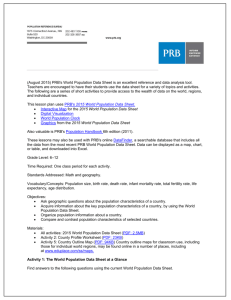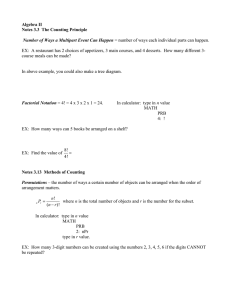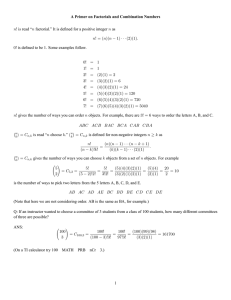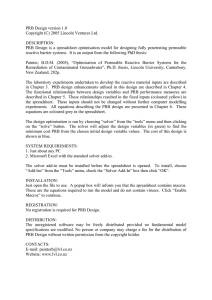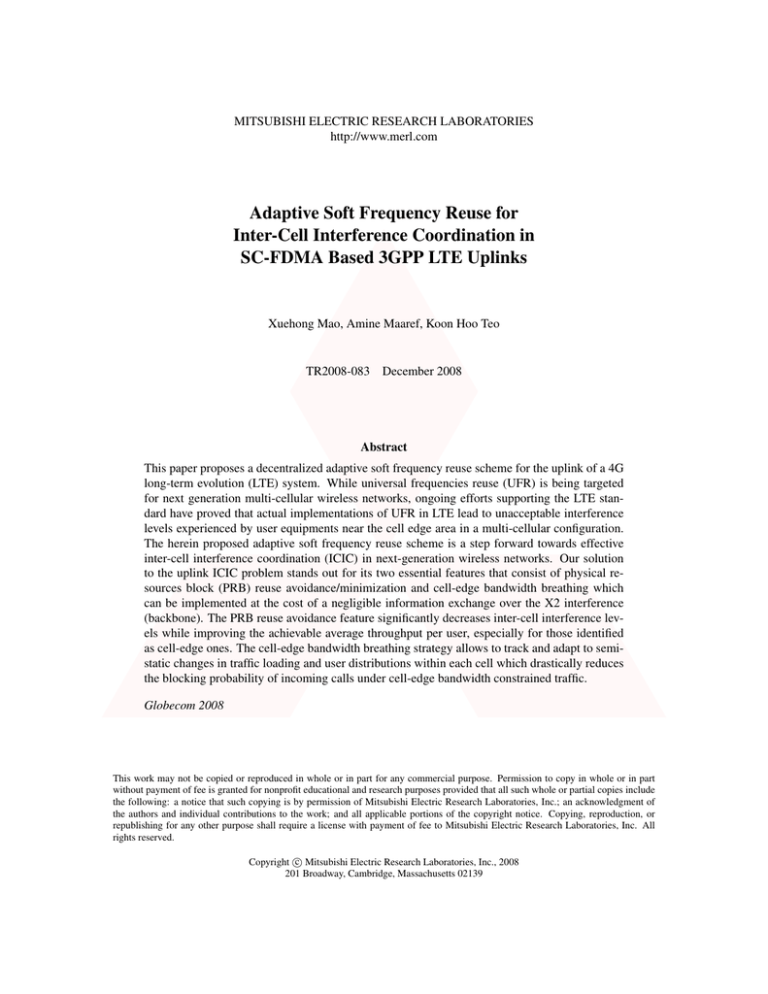
MITSUBISHI ELECTRIC RESEARCH LABORATORIES
http://www.merl.com
Adaptive Soft Frequency Reuse for
Inter-Cell Interference Coordination in
SC-FDMA Based 3GPP LTE Uplinks
Xuehong Mao, Amine Maaref, Koon Hoo Teo
TR2008-083
December 2008
Abstract
This paper proposes a decentralized adaptive soft frequency reuse scheme for the uplink of a 4G
long-term evolution (LTE) system. While universal frequencies reuse (UFR) is being targeted
for next generation multi-cellular wireless networks, ongoing efforts supporting the LTE standard have proved that actual implementations of UFR in LTE lead to unacceptable interference
levels experienced by user equipments near the cell edge area in a multi-cellular configuration.
The herein proposed adaptive soft frequency reuse scheme is a step forward towards effective
inter-cell interference coordination (ICIC) in next-generation wireless networks. Our solution
to the uplink ICIC problem stands out for its two essential features that consist of physical resources block (PRB) reuse avoidance/minimization and cell-edge bandwidth breathing which
can be implemented at the cost of a negligible information exchange over the X2 interference
(backbone). The PRB reuse avoidance feature significantly decreases inter-cell interference levels while improving the achievable average throughput per user, especially for those identified
as cell-edge ones. The cell-edge bandwidth breathing strategy allows to track and adapt to semistatic changes in traffic loading and user distributions within each cell which drastically reduces
the blocking probability of incoming calls under cell-edge bandwidth constrained traffic.
Globecom 2008
This work may not be copied or reproduced in whole or in part for any commercial purpose. Permission to copy in whole or in part
without payment of fee is granted for nonprofit educational and research purposes provided that all such whole or partial copies include
the following: a notice that such copying is by permission of Mitsubishi Electric Research Laboratories, Inc.; an acknowledgment of
the authors and individual contributions to the work; and all applicable portions of the copyright notice. Copying, reproduction, or
republishing for any other purpose shall require a license with payment of fee to Mitsubishi Electric Research Laboratories, Inc. All
rights reserved.
c Mitsubishi Electric Research Laboratories, Inc., 2008
Copyright 201 Broadway, Cambridge, Massachusetts 02139
MERLCoverPageSide2
Adaptive Soft Frequency Reuse for Inter-cell
Interference Coordination in SC-FDMA based
3GPP LTE Uplinks
Xuehong Mao† , Amine Maaref‡ and Koon Hoo Teo‡
† ECE
department, University of Utah, Salt Lake City, UT
E-mail: mao@ece.utah.edu
‡ Mitsubishi Electric Research Laboratories
201 Broadway Cambridge, MA, 02139
E-mail: maaref@merl.com, teo@merl.com
Abstract—This paper proposes a decentralized adaptive soft
frequency reuse scheme for the uplink of 4G long-term evolution
(LTE) systems. While universal frequency reuse (UFR) is being
targeted for next generation multi-cellular wireless networks,
ongoing efforts supporting the LTE standard have proved that
actual implementations of UFR in LTE lead to unacceptable
interference levels experienced by user equipments near the
cell edge area in a multi-cellular configuration. The herein
proposed adaptive soft frequency reuse scheme is a step forward
towards effective inter-cell interference coordination (ICIC) in
next-generation wireless networks. Our solution to the uplink
ICIC problem stands out for its two essential features that consist
of physical resource block (PRB) reuse avoidance/minimization
and cell-edge bandwidth breathing which can be implemented
at the cost of a negligible information exchange over the X2
interface (backbone). The PRB reuse avoidance feature significantly decreases inter-cell interference levels while improving
the achievable average throughput per user, especially for those
identified as cell-edge ones. The cell-edge bandwidth breathing
strategy allows to track and adapt to semi-static changes in traffic
loading and user distributions within each cell which drastically
reduces the blocking probability of incoming calls under cell-edge
bandwidth constrained traffic.
I. I NTRODUCTION
INGLE-carrier frequency division multiple access (SCFDMA), an Fast Fourier Transform (FFT)-precoded
version of orthogonal frequency-division multiple access
(OFDMA), aimed at mitigating the peak-to-average-power
ratio problems typically encountered by OFDMA on the
uplink, has been adopted on the uplink of the 3G Long Term
Evolution (LTE) standard. OFDMA on the other hand is being
targeted for the downlink scenario in addition to its adoption
in both directions (uplink and downlink) in the context of
Worldwide Interoperability for Microwave Access (WiMAX).
For both OFDMA and SC-FDMA, the available bandwidth is
divided into several orthogonal sub-bands each corresponding
to a group of orthogonal subcarriers. The orthogonality feature
among the subbands assigned to each user is an important
aspect of both SC-FDMA and OFDMA since it allows mitigating the intra-cell interference in a multi-cellular wireless
S
This work was done while Xuehong Mao was a graduate intern at
Mitsubishi Electric Research Laboratories (MERL).
network. As a result, the bulk of the interference management
problem for the next generation of wireless networks reduces
to dealing with the interference into a target cell that originates
from neighboring cells, a.k.a inter-cell interference.
In a multi-cellular network employing frequency reuse
across different cells, inter-cell interference occurs when
neighboring cells assign the same frequency bandwidth to
different user equipments (UEs). In such a context, it is only
natural that the most severe form of inter-cell interference is
the result of frequency collisions that occur on or near the
edge of a given cell. Inter-cell interference coordination (ICIC)
techniques, whereby UEs in a target cell are allocated orthogonal frequency resources to all or portion of the interfering
UEs in the adjacent cells, can effectively reduce inter-cell
interference effects especially in the cell-edge area. In this
vein, various frequency reuse schemes have been proposed
in the literature [1]–[3]. The most straightforward approach is
the so-called fixed frequency reuse scheme whereby the whole
available bandwidth is divided into three non-overlapping parts
which are assigned to three neighboring cells. This frequency
planning scheme allows to eliminate frequency collisions at
the cost of spectrum efficiency. To overcome this drawback, a
soft frequency reuse (SFR) scheme has been introduced in [3].
As depicted in Fig. 1, the SFR scheme divides the available
spectrum into two reserved parts: a cell-edge bandwidth and
a cell-center bandwidth. UEs within each cell are also divided
into two groups, interior cell-center UEs and exterior cell-edge
UEs, depending on which type of bandwidth they are assigned
or have access to. Cell-edge UEs are restricted to the reserved
cell-edge bandwidth while cell-center UEs have exclusive
access to the cell-center bandwidth and can also have access
to the cell-edge bandwidth but with less priority than celledge UEs. Usually, the cell-edge bandwidth in one cell/sector
is fixed to one third of the entire available bandwidth with the
aim of ensuring that adjacent cells/sectors can allocate nonoverlapping frequency bands for their cell-edge traffic.
The SFR scheme outlined in [3] is a bandwidth efficient
ICIC mechanism which is typically most effective in static
scenarios with evenly distributed traffic across the whole network. However, more often than not, the traffic load changes
978-1-4244-2324-8/08/$25.00 © 2008 IEEE.
This full text paper was peer reviewed at the direction of IEEE Communications Society subject matter experts for publication in the IEEE "GLOBECOM" 2008 proceedings.
Figure 1. A seven-cell hexagonal system layout and frequency planning for
the SFR scheme.
semi-statically and/or is uneven among neighboring cells, then
it observed that there is room for improving the performance
of the SFR scheme at the cost of a negligible exchange of
information between neighboring eNodeBs.1 In that sense, we
refer to our proposed adaptive soft frequency reuse scheme
as a semi-distributed one that dynamically adapts to semistatically changing traffic load and user distributions among
neighboring cells, while relying on a per frequency sub-band
indicator exchange between adjacent eNodeBs over the X2
interface, indicators that are currently being discussed within
the 3GPP community.
The remaining of this paper is organized as follows. The
basic assumptions and system model for the inter-cell interference coordination problem in the LTE uplink are presented
in Section II. In Section III, an SFR-based ICIC scheme with
frequency reuse avoidance is proposed. Combined with the
novel indicator-based cell-edge bandwidth breathing strategy,
an adaptive SFR scheme is then identified. Simulation results
are presented in Section IV highlighting the benefits of the
proposed ICIC mechanism and concluding remarks are drawn
in Section V.
II. S YSTEM M ODEL AND P ROBLEM F ORMULATION
Radio resource management in SC-FDMA based LTE uplink involves three dimensions: frequency, time and space. The
basic resource element considered in this paper is the physical
resource block (PRB) which spans both frequency and time
dimensions. The component frequencies of one PRB can be
either contiguous or disjoint. The time duration of the PRB is
defined by one transmission time interval (TTI). By judiciously
coordinating the usage of PRBs in adjacent cells, frequency,
time and spatial diversity can be leveraged.
A. Basic Assumptions
We consider the uplink direction (from UEs to eNodeBs)
of a seven-cell hexagonal layout as illustrated in Fig. 1 and
assume the following throughout the paper:
1) Intra-cell interference is successfully avoided. Indeed,
the scheduler of each eNodeB ensures that PRBs will
1 eNodeB
commonly refers to a base station in LTE terminology.
not be simultaneously assigned to more than one UE
within each cell. By further assuming that orthogonality
among sub-carriers can be adequately maintained then
intra-cell interference can be ignored.
2) UEs are categorized as cell-center and cell-edge UEs
based on reported measurements of their received signal
reference signal (RSRP) [4]. It should be noted that
several methods other than the geometry factor can be
employed to distinguish between cell-center and celledge UEs. Although different methods may lead to
different simulation results, we should stress that the
ensuing implications fall outside the scope of this paper.
A cell-edge UE may be blocked or denied access if
there is a shortage of available cell-edge PRBs within
the current cell. A cell-center PRB may be blocked if
there are no more cell-center PRBs or cell-edge PRBs to
be allocated. Since the number of PRBs within each cell
is limited, there exists a limit on the number of active
UEs within the cell/system.
3) Inter-cell interference is the major problem we try to
minimize since adjacent cells are allowed to reuse the
same set of PRBs in order to achieve a frequency reuse
factor close to one. Owing to its higher bandwidth
efficiency, SFR is strongly tipped for use in LTE systems
for ICIC purposes. Therefore two UEs in adjacent cells
are allowed to transmit on the same PRBs and one
objective of the proposed ICIC scheme is to minimize
the probability of such events which we refer to as PRB
reuse.
4) Taking the uplink scenario into account, two transmission power levels are imposed on cell-center and celledge UEs. For cell-edge UEs, in order to guarantee the
required SINR, full transmission power P0 is applied.
However, for cell-center UEs, since they are closer to
the serving base station, a power reduction is suggested
in order to reduce the potential interference on other
UEs, without violating the SINR requirement. Hence
cell-center users transmit power is set to αP0 , where
α is some tunable constant such that 0 ≤ α ≤ 1.
B. Resource Usage Modelling
Denote by L the number of cells in the system, e.g. L = 7
as per our working assumption in this paper and by N the
number of available PRBs that can be used for transmission
in each TTI and in each cell. Besides, let Ml be the number of
UEs and Ml be the set of indexes denoting the UEs belonging
to cell l, respectively, where l = 1, · · · , L. Therefore, the total
L
number of UEs in the system is Mt = l=1 Ml .
1) Resource Allocation Matrices: Let YMt ×N = [ymn ] and
XL×N = [xln ] be resource allocation matrices from the UEs
and eNodeBs perspective, respectively, with elements ymn and
xln defined as follows:
ymn
1, if PRB n is used by cell-edge UE m
α, if PRB n is used by cell-center UE m
=
0, otherwise,
978-1-4244-2324-8/08/$25.00 © 2008 IEEE.
This full text paper was peer reviewed at the direction of IEEE Communications Society subject matter experts for publication in the IEEE "GLOBECOM" 2008 proceedings.
and
III. A DAPTIVE S OFT F REQUENCY R EUSE S CHEME
xln =
1, if PRB n is used by cell-edge UE at cell l
α, if PRB n is used by cell-center UE at cell l
0, otherwise,
respectively. Since for each cell, PRB
usage is restricted to one
UE at any given TTI, then xln = m∈Ml ymn . Therefore X
is uniquely determined by Y.
t ,N
2) Interference Sets: Define J = {Jmn }M
m,n=1 where for
m = 1, · · · , Mt and n = 1, · · · , N , Jmn represents the set
of UE m’s interfering set of eNodeBs on PRB n, where Jmn
denotes any subset of {1, 2, ..., L} including the empty set ∅
which refers to the case where no other UE from neighboring
cells is concurrently using the same PRB n.
Careful observation of the above notations reveals that
given the resource allocation matrix Y as well as the serving
eNodeBs of UEs within the considered coverage area, the
remaining resource allocation variables X and J can be easily
deduced. Therefore, the signal-to-interference-and-noise ratio
(SINR) for UE m on PRB n can be expressed as:
SINRmn =
N0 +
ymn P0 β0,m
Jmn ∈Jmn P0 xJmn ,n βJmn ,m
The proposed adaptive soft frequency reuse (ASFR) scheme
whose flow chart diagram is illustrated in Fig. 2, comprises
three main parts. First, we randomly assign reserved PRBs to
requesting UEs according to their type, i.e. cell-center PRBs
to cell-center UEs and cell-edge PRBs to cell-edge UEs. Then,
based on the previous random allocation, we redistribute the
reserved cell-edge bandwidth according to the traffic load in
each cell. Finally, we apply the PRB reuse avoidance algorithm
described below to each cell and decide whether to accept the
reallocation or not.
In contrast to the resource allocation strategy described
in [1], the proposed ASFR scheme is more decentralized in
the sense that it does not require a radio network controller
(RNC). When a cell detects that it faces a shortage of celledge PRBs, it will send out a borrowing request for cell-edge
PRBs reserved for its adjacent cells. If any cell-edge PRBs in
adjacent cells are not currently occupied, the overloaded cell
can benefit from it thereby being able to accommodate more
cell-edge traffic.
(1)
where β0,m denotes the path loss between UE m and its
serving eNodeB, βJmn ,m represents the path loss between the
interfering UE in eNodeB Jmn and UE m’s serving eNodeB
and N0 is the eNodeB thermal noise variance.
3) Problem Formulation: PRB scheduling is formulated as
an optimization problem with the objective of maximizing the
total throughput expressed as
Mt
Tm
[bits/s]
(2)
m=1
where
Tm = WPRB
N
log2 (1 + SINRmn )
n=1
is the throughput of UE m and WPRB is the PRB bandwidth,
subject to the following constraints:
1) Uneven traffic loading such that the traffic load of each
cell TLl is given by
TLl =
N
ymn /N,
l = 1, · · · , L
(3)
m∈Ml n=1
where . denotes the ceil operator.
2) No
PRB sharing within each cell, i.e. xln =
m∈Ml ymn .
3) Reserved cell-edge bandwidth in each cell is one third
of the available bandwidth, i.e.
N
N
N
xln =
ymn ≤ , l = 1, · · · , L
3
n=1
n=1
m∈Ml
where . denotes the floor operator.
Figure 2.
Flow chart for the adaptive SFR scheme.
A. PRB Allocation Step
This first step ensures that no PRB is assigned to two
different UEs within one cell. The total bandwidth is divided into two parts: cell-edge bandwidth and cell-center
978-1-4244-2324-8/08/$25.00 © 2008 IEEE.
This full text paper was peer reviewed at the direction of IEEE Communications Society subject matter experts for publication in the IEEE "GLOBECOM" 2008 proceedings.
bandwidth. The cell-center UEs are allowed to access the
cell-edge bandwidth if it is not occupied. For each UE, the
eNodeB randomly assigns one available PRB according to
the UE’s category (cell-edge or cell-center). Since the celledge bandwidth assigned for adjacent cells is non-overlapping
(as shown in Fig. 1), two cell-edge UEs from adjacent cells
will be prevented from using the same PRB. However, PRBs
taken by cell-edge UEs from one cell might be assigned to
other UEs at cell-center in a neighboring cell. In a downlink
scenario, this might not cause a serious problem. However, in
the uplink scenario, cell-edge UEs might be a non-negligible
source of interference to cell-center UEs, so more so as the
cell-edge UEs usually have a higher transmission power. When
two UEs from different cells use the same PRB, we refer to
such an event as PRB reuse. The third step of ASFR aims at
reducing the probability of PRB reuse in as much as possible in
order to improve the achievable throughput. After performing
the randomized PRB allocation, the resource allocation matrix
Y(0) is obtained. As a result, the two resource allocation
variables X(0) , J(0) can be generated by the mapping functions
f (·) and g (·), respectively.
C. PRB Reuse Avoidance
B. Cell-edge Bandwidth Breathing
The re-allocation will be accepted if SINR(l) is increased and
rejected otherwise. Simulation results provided below show
that the proposed RA algorithm significantly reduces the reuse
probability especially at mid-load traffic scenarios.
Although the breathing mechanism for cell-edge bandwidth
is intuitively very appealing, realizing it in practice is no trivial
task. In the proposed scheme, a high interference indicator
(HII) currently in the process of being standardized within
LTE, is used. HII is the message whereby a cell informs
its neighbors about its decision on ICIC. The neighboring
cells can then respond by avoiding to schedule their cell-edge
UEs on the PRB(s) indicated by the received HII(s). After
sending out a HII to its neighbors, the source cell can monitor
via available measurements if the interference levels on the
indicated PRB(s) has been reduced or not.
The format and content of the HII message has yet to
be agreed upon in the LTE standard. However, the current
consensus seems to be that HII employs one bit per PRB [5].
We abide by this agreement and propose the so-called celledge bandwidth sharing (CEBS) algorithm which allocates
the cell-edge bandwidth dynamically according to the traffic
load of the network. In our algorithm, each cell maintains an
available cell-edge PRB set and an available cell center PRB
set. When a cell is overloaded at cell edge (borrowing cell), it
observes the HII(s) sent by its neighbors. Since the frequency
bandwidth reserved for each cell is known as the reserved
PRB set at the initialization stage, we can compare the PRBs
indicated by HII and the reserved PRB set to determine for
each cell the ‘free’ or borrowable cell-edge PRB(s). In order
to optimize the cell-edge bandwidth breathing procedure, the
borrowing cell first asks for ‘free’ PRB(s) from the cell that has
most borrowable PRBs. Also, to avoid intra-cell interference,
the borrowed PRB(s) should be excluded from the borrowing
cell’s set of available cell-center PRBs. After executing the
CEBS algorithm, the available cell-center and cell-edge PRB
sets are reallocated according to the traffic load within each
cell.
Inter-cell interference arises as a result of PRB reuse by
UEs located in neighboring cells. In the context of soft
frequency reuse, since cell-edge to cell-edge PRB collisions
are inherently taken care of, those suffering the most from
inter-cell interference are cell-center UEs that reuse the same
PRBs as cell-edge UEs. Such PRB reuse cases can also be
detected via HII exchange. Therefore, whenever such PRB
reuse cases are detected, we employ our PRB reuse avoidance
(RA) algorithm to try to prevent them by allocating another
cell-center PRB (subject to availability) to the cell-center UE
in question.
Each eNodeB updates the available cell-center PRB set
when receiving the HII from the neighboring cells and then
chooses a PRB from the updated cell-center PRB set that is
reused multiple times. After reallocation, the resource allo
cation matrix corresponding to cell l is captured by y m∈Ml .
Then, the total SINR in cell l is evaluated using (1) as
SINR(l) =
N
SINRmn ,
l = 1, · · · , L
(4)
m∈Ml n=1
IV. S IMULATIONS AND R ESULTS
In order to evaluate the merits of the proposed ICIC
schemes, we focus on the uplink of a 7-cell hexagonal layout
with omnidirectional antennas at the center of each cell. In
case of a sectorized network, the SFR-based ICIC schemes
proposed herein may apply to a cluster of adjacent sectors
belonging to three different sites. We assume delay sensitive
traffic model for UEs, hence UEs which cannot be serviced
due to a shortage on the available PRBs (according to the
adopted ICIC scheme) are accounted for as contributing to
the blocking probability.
A number of UEs are uniformly dropped within each cell.
The cell edge area in each cell is assumed to be the outer one
third of the cell area. We further assume that the traffic load
is unevenly partitioned between the seven cells; i.e., only the
central cell is assumed to be overloaded at cell edge whereas
the remaining cells are under-loaded. Only one PRB can be
assigned to each active UE per TTI. The main simulation
parameters are summarized in Tab. 1.
The universal frequency reuse (UFR) whereby PRBs are
randomly assigned to the different users in each cell irrespective of their category (cell-edge or cell-center UEs) is
taken as a reference scheme. Another reference scenario that
we consider is the conventional SFR scheme which assigns a
fixed non-overlapping cell edge bandwidth (usually one-third
of the total bandwidth per cell) to a cluster of three adjacent
cells. Enhanced SFR (ESFR) is an enhanced version of SFR
that applies the RA algorithm. As we mentioned earlier, the
proposed ICIC scheme is denoted as ASFR.
978-1-4244-2324-8/08/$25.00 © 2008 IEEE.
This full text paper was peer reviewed at the direction of IEEE Communications Society subject matter experts for publication in the IEEE "GLOBECOM" 2008 proceedings.
Table I
M AIN S IMULATION PARAMETERS .
Value
10 MHz
2 GHz
7
750 m
1/3
L=128.1 + 37.6 1og10(R/1000), R in m
8 dB
-174dBm/Hz
1
48 PRBs (PUSCH), 2 PRBs (PUCCH)
16
Cell Edge users, SNR = 10 [dB]
0.72
UFR
SFR
0.7
ESFR
ASFR
0.68
0.66
0.64
SE
Parameter
Bandwidth
Carrier frequency
# of cells
Cell radius
Ratio of cell edge area
Distance-dependent path loss
Shadowing standard deviation
Thermal noise
# of PRBs per UE
Total # of PRBs
# of reserved cell-edge PRBs
outperform SFR especially in mid-load traffic conditions, i.e.,
when the traffic load is between 40% and 70%.
0.62
0.6
Fig. 3 shows the average SINR per UE located at cell
edge for the different ICIC schemes considered in this paper.
It is observed that ESFR yields a significant improvement
compared to SFR in terms of achievable SINR owing to
the RA algorithm. One can also observe that ESFR slightly
outperforms ASFR in terms of average SINR. However, ASFR
yields higher throughput and lower blocking probability as
is shown in Fig. 4 and Fig. 5, respectively, which makes
it the better alternative particularly under stringent resource
constraints.
Cell Edge users, SNR = 10 [dB]
10
UFR
SFR
ESFR
EAFR
Average SINR per UE [dB]
9
8
0.58
0.56
0.54
0.45
Figure 4.
0.5
0.55
0.6
0.65
Cell Edge Traffic Load
0.7
0.75
0.8
BW efficiency comparison for different allocation scheme.
The payoff for this small increase in the interference level
seen by each UE under the ASFR compared to the ESFR
is a huge improvement in the blocking probability as can
be observed from Fig. 5. ESFR yields the same blocking
probability as SFR when the system is overloaded in terms
of cell-edge traffic. It is worthwhile to mention that the
three schemes perform worse than UFR in terms of blocking
probability since our basic assumption consists of considering
an under-loaded system in each cell whereas each cell has
access to the full bandwidth in the UFR scheme.
7
All users, SNR = 10 [dB]
0.045
6
0.04
5
0.5
Figure 3.
0.55
0.6
0.65
Cell Edge Traffic Load
0.7
0.75
Blocking Probability
0.035
4
0.45
0.8
SINR comparison for different allocation scheme.
0.03
0.025
Fig. 4 shows the normalized spectral efficiency (SE) as
function of the cell-edge traffic load. The SE is defined as
SE =
Mt
3
δm Tm
N L log2 (1 + SNR) m=1
(5)
where δm = 1 if UE m is located at cell edge, and δm = 0
otherwise. In eq. (5), the total throughput at cell-edge is
normalized by an upper bound on the achievable throughput
at cell-edge. Simulation results show that the proposed ASFR
scheme achieves the best results among the ICIC schemes
under consideration in terms of cell-edge throughput. As can
be seen from this figure, the two proposed ICIC schemes well
ESFR
0.02
ASFR
0.015
0.45
0.5
Figure 5.
Blocking probability versus traffic load of the system.
0.55
0.6
0.65
Cell Edge Traffic Load
0.7
0.75
0.8
V. C ONCLUSION
In this paper, we show the benefits of applying an adaptive
soft frequency reuse scheme in the 3GPP LTE systems, both in
terms of throughput enhancement and QoS guaranty through
978-1-4244-2324-8/08/$25.00 © 2008 IEEE.
This full text paper was peer reviewed at the direction of IEEE Communications Society subject matter experts for publication in the IEEE "GLOBECOM" 2008 proceedings.
the reduction of service outage probability. We recommend
that the SFR-based ICIC scheme with PRB reuse avoidance
and cell-edge breathing, as proposed in the paper, be implemented in LTE systems as we show it can substantially impact
LTE performance.
Our simulation results for the uplink scenario show that
the proposed methods can dramatically reduce the dropping
probability when traffic load is uneven among sectors/cells,
e.g. when some sectors/cells experience relatively heavier
traffic load on their cell-edge bandwidth. It is noteworthy that,
in line with previous contributions pertaining to uplink ICIC
[6], [7], more gain is observed for the proposed ICIC scheme
when the network is mid-loaded (traffic load averaged over all
cells). Intuitively, this is due to the fact that mid-load traffic
conditions allow for some “room” to maneuver that can be
leveraged by ICIC.
R EFERENCES
[1] G. Li, H. Liu, “Downlink Radio Resource Allocation for Multi-Cell
OFDMA System,” IEEE Tran. Wireless Commun., vol. 5, no. 12, pp
3451-3459, Dec. 2006
[2] Y. Xiang, J. Luo, C. Hartmann, “Inter-cell Interference Mitigation through
Flexible Resource Reuse in OFDMA based Communication Networks”,
European Wireless 2007.
[3] R1-050507, ‘Soft Frequency Reuse Scheme for UTRAN LTE’, Huawei.
3GPP TSG RAN WG1 Meeting #41, Athens, Greece, May 2005.
[4] R1-080361, ‘Additional RSRP reporting trigger for ICIC’, Ericsson. 3GPP
TSG RAN WG1 Meeting #51b, Sevilla, Spain, January 2008.
[5] R1-080361, ‘Summary of email discussion on UL and DL ICIC’, Telecom
Italia. 3GPP TSG RAN WG1 Meeting #52, Sorrento, Italy, February
2008.
[6] R1-080950, “Performance of proactive uplink ICIC under fractional
load”, Nokia Siemens Networks, Nokia. 3GPP TSG RAN WG1 #52,
Sorrento (Italy), February, 2008.
[7] R1-074444, “On Inter-Cell Interference Coordination Schemes without/with Traffic load Indication”, Ericsson. 3GPP TSG RAN WG1 #50b,
Shangai (China), October, 2007.
978-1-4244-2324-8/08/$25.00 © 2008 IEEE.
This full text paper was peer reviewed at the direction of IEEE Communications Society subject matter experts for publication in the IEEE "GLOBECOM" 2008 proceedings.

